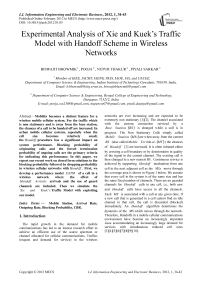Experimental Analysis of Xie and Kuek's Traffic Model with Handoff Scheme in Wireless Networks
Автор: BISWAJIT BHOWMIK, POOJA, NUPUR THAKUR, PIYALI SARKAR
Журнал: International Journal of Information Engineering and Electronic Business(IJIEEB) @ijieeb
Статья в выпуске: 1 vol.4, 2012 года.
Бесплатный доступ
Mobility becomes a distinct feature for a wireless mobile cellular system. For the traffic which is non stationary and is away from the base station, the chances of a call to be handed off are increased. In urban mobile cellular systems, especially when the cell size becomes relatively small, the procedure has a significant impact on system performance. Blocking probability of originating calls and the forced termination probability of ongoing calls are the primary criteria for indicating this performance. In this paper, we report our recent work on closed form solutions to the blocking probability followed by dropping probability in wireless cellular networks with . First, we develop a performance model of a cell in a wireless network where the effect of arrivals and the use of guard channels are included. Then we simulate the Traffic Model with exploiting our model.
Mobile Station, Arrival Rate, Outgoing Rate, Blocking Probability, CBR
Короткий адрес: https://sciup.org/15013106
IDR: 15013106
Текст научной статьи Experimental Analysis of Xie and Kuek's Traffic Model with Handoff Scheme in Wireless Networks
Published Online February 2012 in MECS
The rapid growth in the demand for mobile communications has led to an intense research effort to achieve an efficient use of the scarce spectrum or channel allocated for cellular communications. Traffics (request and demand for service) in the wireless networks are ever increasing and are expected to be extremely non stationary [1][2]. The channel associated with the current connection serviced by a Base Stations (BS) is changed while a call is in progress. The Non Stationary Calls simply called Mobile Stations (MSs) are when away from the current BS (also called Mobile Ter min al, (MT)) the chances of Handoff [3] are increased. It is often initiated either by crossing a cell boundary or by deterioration in quality of the signal in the current channel. The existing call is then changed to a new nearest BS . Continuous service is achieved by supporting Handoff mechanism from one cell to the next adjacent cell as the MSs move through the coverage area is shown in Figure 1 below. We assume that every cell in the system is of the same size and has the same fixed number of channels. There are no guarded channels for Handoff calls in any cell, i.e., both new and Handoff calls have access to all the channels. Each MS is associated with a call at any given time. If a new call that is generated in a cell cannot find an idle channel in that cell, the call is discarded (blocked) immediately. An Handoff algorithm determines the dynamics of the MS which moves through the network. Therefore, Handoffs in a mobile cellular communications environment have become an increasingly important issue accommodating an increasingly large demand for services with simultaneous reduced cell sizes [3][4][5][6][7][8][9][10].
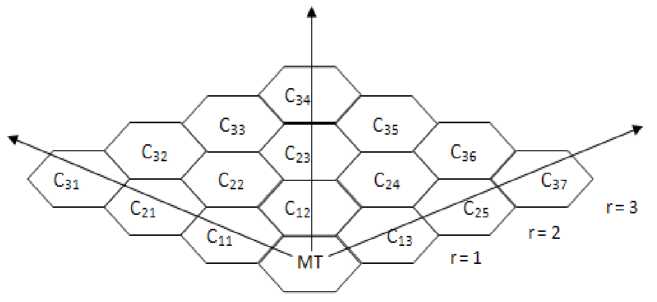
Figure 1. Same Column and Non-column Cellular Configuration for r = 3
In urban mobile cellular radio systems, especially when the cell size becomes relatively small, the Handoff mechanism has a significant impact on primary system performance criteria: Blocking probability of originating calls ( B O ) , Blocking probability of Handoff calls ( B H ) , and the forced termination probability of ongoing calls [3][8]. Before analyzing these performance criteria, it is important to establish a traffic model. In this paper we propose to modelling, implement and simulate the Xie and Kuek ' s Traffic Model [3] with Handoff behavior for mobile network. A simulation model EATM (Experimental Analysis of Traffic Model) with priority Handoff scheme is developed to investigate the Handoff performances. Simulation results show that measurement of blocking probabilities for both originating and Handoff calls is an impressive achievement of the model. In addition to this, the proposed model can increase Call Blocking Rate ( CBR ) as derived in [1][8][11][12] and shown in Equation (11) of Handoff calls.
2. Proposed Work
Every cell in cellular network architecture (shown in Figure 1) is served by an underlying BS that is MT . BSs are connected together by using a wireless network. Figure 2(a) shows the fact that each hexagonal cell A, D, Q, P, X, Y, and Z are nothing but each MT . MSs generally move in the coverage area (each hexagon) similar to Figure 2 [13][14][15] and Table I [8] and when moving from a cell to another cell, Handoff occurs [3]. Movements may be made away from and/or towards the MT . h owever , movements away from the current MT is primarily responsible for Handoff to be taken place. For the time being suppose cell a in f igure 2(a) is our current BS . h owever , one-third of the coverage area of this BS is considered in this paper and equivalent to Figure 1.
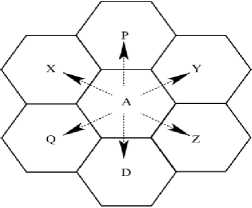
(a)
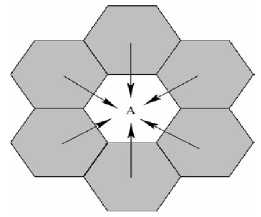
(b)
Figure 2. Mobility of Mobile Stations ( MSs )
When MSs move irrespective of the direction of movements in the cell of the current servicing BS then the following two cases and their corresponding sub cases [15] may arise: First, Call Acceptance - (a) A successful Handoff completion to the target cell, (b) New call arrival in the target cell, and (c) Active mobile terminal increases its resource demands. Second, Call Rejection - (a) A successful Handoff completion from the target cell. (b) Call termination in the target cell and (c) Active mobile terminal decreases its resource demands.
The current researches on Handoff mainly involve following two issues: (1) How does the Handoff process affect performance of wireless cellular system; (2) How do we design Handoff scheme so that channel resources are used efficiently and quality of service (QoS) is still guaranteed.
Recently, many analytical and simulation models have characterized the Handoff problems. Our approach provides high precise location and tracking of MTs by exploiting advanced traffic models. Some of these we have studied it in [1][7][8].
Table I: Generated Handoff Approaches
|
Approach |
Movement of MSs w.r.t MT |
Adjacent Level |
Position of Cells Column |
|||
|
Towards |
Away from |
Upper |
Lower |
Same Column |
Not Same Column |
|
|
I |
N |
Y |
Y |
N |
Y |
N |
|
Y |
N |
N |
Y |
Y |
N |
|
|
II |
N |
Y |
Y |
N |
Y |
N |
|
Y |
N |
N |
Y |
N |
Y |
|
|
III |
N |
Y |
Y |
N |
N |
Y |
|
Y |
N |
N |
Y |
Y |
N |
|
|
IV |
N |
Y |
Y |
N |
N |
Y |
|
Y |
N |
N |
Y |
N |
Y |
|
Here we have extended our work [16] with Xie and Kuek ' s Traffic Model [3]. Our approach EATM Model takes more advantages over previous models described in [1][7][8]. Major functionalities of the proposed model in this paper are organized in as follows:
First, we present an expression to Determine Arrival Rate ( λo ) of the calls followed by the expression of their Departure Rate ( µ ) Determination. Next, we choose a model through Traffic Model Selection. Next, we are going to implement a Priority Handoff Scheme. And last we have determined Call Blocking Rate of both originating calls and Handoff calls.
-
2.1 Determination of Arrival Rate
-
2.2 Determination of Departure Rate
-
2.3 Selection of Traffic Model
Number of MSs (also called Traffic Density [17]) varies location to location. And this location on the contrary affects arrival rate λo of originating calls from MSs to nearest BS ( MT ) . Likewise number of BSs varies. Assuming distance D [18][19] between two base stations is 1 km, λo [3] has been determined in S 2 BPQ model [16] as:
λ o = Total Numberof Subscriber(S) in thatRegion (1) Total Numberof MTs (X)
The departure rate µ (say, number of mobile stations get serviced in unit time) should be at least equal to arrival rate λo such that waiting for getting service becomes zero. Although in reality µ is much larger than λo . e xploiting p oison d istribution [17], with the traffic intensity factor ρ (defined as λo/µ ) lies between 0 and 1, departure rate µ has been established in S 2 BPQ Model [16] as:
0 ≤ λ o ≤ µ (2)
Every cell in cellular network architecture ( shown in f igure 1) is served by an underlying BS . e stablishment of a traffic model, in cellular system, is more imperative before analyzing the performance of the system [8][16]. Several traffic models [3][20] as well as different schemes [21][22][15][10] have been established on basis of making different assumptions about user mobility. o ne of them is the e xpected r ate of Handoff ( λH ) .
For our purpose Xie and Kuek ' s Traffic Model [3] shown in Equation (3) has been chosen as underlying implementation model with the assumption that the Arrival Rate of Handoff calls ( λH ) is determined by:
λ H = ∏ ( E [ c ], µ c - dwell ) (3)
Where,
E [ c ] = the average number of calls in a cell µc - dwell = the outgoing rate of mobile users
-
2.3.1 Determination of E[c]
For a maximum radial distance R max (maximum distance from the current BS that provides services its MSs and after the distance an MS forcefully changes from current BS to another BS ) from the underlying network, total cells N under a BS is given by:
∑ R max (2 × r + 1) (4)
r = 1
Average number of MSs we called here as Subscribers ( Subs ) , in any cell j at radial distance r (represented as Crj in Figure 1) is obtained by Equation (5):
Subs =
Total Number of MSs (S)
Total Number of Cells (N)
Let us consider average number of calls originated by a Sub ( MS ) is Calls Per Day Per Subscriber ( CPD ) . Thus,
E [ c ] = П ( Subs , CPD ) (6)
-
2.3.2 Determination of µc—dwell
Assuming that MSs move any one of the three directions - outwards, inwards and along the same radial level (shown in both Figure 1 and Figure 2) , the probability of MSs for simplicity moving outwards is one - third . Since, in every radial distance r < R max , there are 2 x r + 1cells, thus, average number of calls going outwards (away from the current BS ) for N cells are given by:
Calls ( T ) = - Y R max Subs x CPD x (2 x r + 1) (7)
-
3 ^ r = 1
Out of the total number of callers ( MSs ) going out from one radial level to the other, let us assume for the time being again one - third of them come back to the previous radial level. Therefore, total number of calls coming inwards (towards the underlying BS ) is:
Calls (Ф) = П(1Д Calls (T))
Effective outgoing calls for the base station are therefore obtained by the Equation (9) as:
Effective Calls (T) = Calls (T) - Calls (Ф)(9)
Now, for Equation (3) we can compute the outgoing rate of mobile users’ pc - dwell and it is given by:
J „ Effective Calls( T )
pc - dwell =
Total Number of Cells (N)
2.4 . Priority Handoff Scheme
2.5 Determination of Call Blocking Rate
3. Numerical Results3.1 Observation I
An MS approaches cells from a cell with significant signal strength as priority set to Handoff requests by assigning channels SR exclusively for Handoff calls out of S channels. Both originating calls and Handoff requests share the remaining SC = S - S R channels. The blocking probabilities, B O for an originating call, and BH of a Handoff request have been determined by Equations 1.22, and 1.23 in [3]
with the steady-state probabilities P (0) and P ( i ) at states "0" and " i "as expressed in Equations. 1.20 , and 1.21 in [3] respectively.
An MS when initiates a call generally expects to be serviced and enqueued in priority queue. Afterward a call gets serviced by its current MT taking advantage of Splay operations [16][23] on the Splay Tree [23] implementation of the priority queue followed by selection of the call from the tree using SIRO [16][17] queuing principle for providing service. At particular level r , 1 < r < R max number of calls blocked i.e. Call Blocking Rate ( CBRr ) can be decided by the Equation (11). This blocking does not mean discard of calls rather number calls gets serviced.
CBR r = 3 П ( R j , B o ,(2 x r + 1)) (11)
It is generally expected to be 90-100% so that the Call Dropping Rate ( CDRr ) at a r < R max [1][8] is minimum as much as possible.
The parameters used for simulation are commonly used to analyze Handoff performance. Simulation of the suggested model has been performed in MATLAB Version 7.6.0.324 (R2008A). Numerical values of the fundamental parameters for Handoff initiation, arrival rate A O , and the departure rate p are based on COAI Report [24][25] for our beloved Megacity Kolkata. And they are set as A O = 1991 , and p = 2212 [13]. Exploiting these numerical values and inheriting necessary data from [16], all the Equations (3) through (10) and section 2.4 in this paper we have shown two observations.
Let us suppose that a mobile station makes at least 5 requests per day. Other values are shown in Table II. Graphical views of the Table II and followed by it, have been shown for the parameters A H , B O , and B H with varying radius (radial) distance in Figures 3 to 5 respectively.
Table II: Performance Metrics for Different Parameters at Radial Levels
|
Parameters |
Outgoing Calls |
Incoming Calls |
Effective Calls |
µ c |
λ o |
µ |
P(0) |
Average B o |
|
|
221.249 |
73.749 |
147.499 |
0.6584 |
22.885 |
25.427 |
0.2363 |
0.7636 |
||
|
λ h |
29.26776 185.3625 |
48.77959 204.8743 |
68.29143 224.3861 |
87.80327 107.3151 126.8269 146.3388 243.898 263.4098 282.9216 |
165.8506 |
||||
|
Bo |
0.25456 0.82524 |
0.40729 0.86543 |
0.51639 0.9018 |
0.60124 0.935 |
0.67066 0.96555 |
0.72941 0.99383 |
0.78032 1.0202 |
||
|
B h |
0.092985 0.3365 |
0.12777 0.16256 0.37129 0.40608 |
0.19735 0.23214 0.44087 0.47566 |
0.26693 0.51045 |
0.30172 0.54524 |
||||
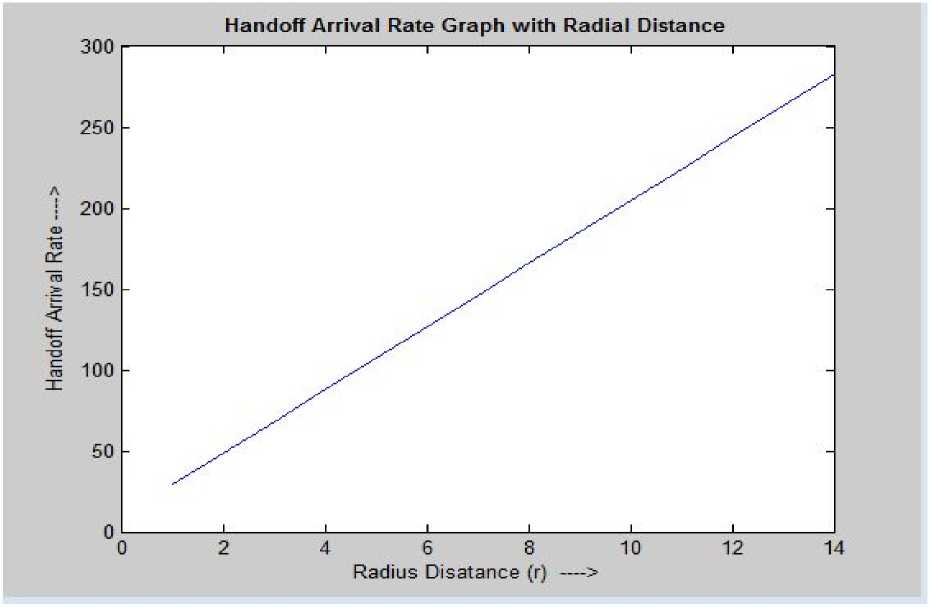
Figure 3. Handoff Arrival Rate vs. Radial Distance
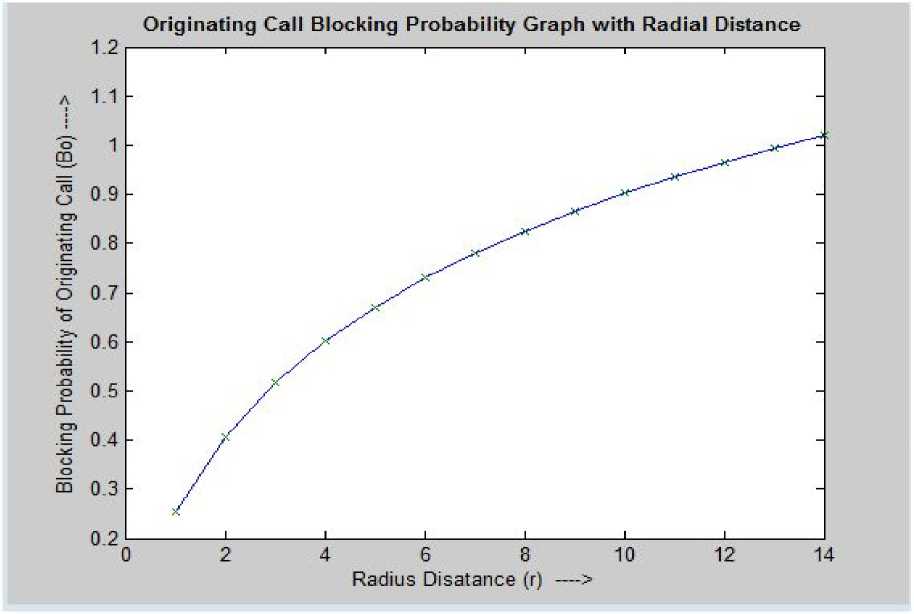
Figure 4. Blocking Probability of Originating Call vs. Radial Distance
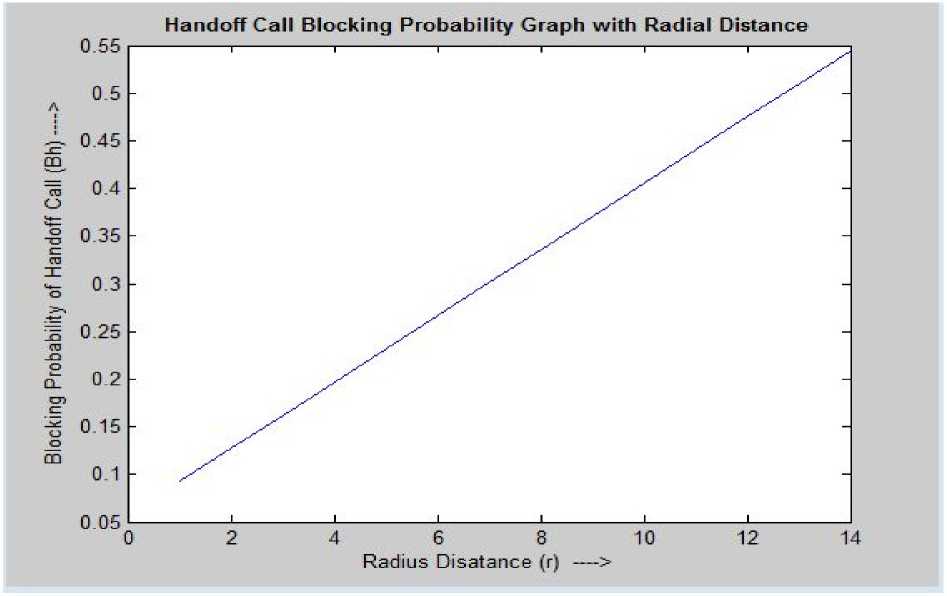
Figure 5. Blocking Probability of Handoff Call vs. Radial Distance
-
3.2 Observation II
Let us suppose that a mobile station makes at least 6 requests per day. Other values are shown in Table III. Similarly graphical views of the Table III and followed by it, have been shown for the parameters λH , BO , and BH with varying radius (radial) distance in Figures 6 to 8 respectively.
Table III: Performance Metrics for Different Parameters at Radial Levels
|
Parameters |
Outgoing Calls |
Incoming Calls |
Effective Calls |
µ c |
λ o |
µ |
P(0) |
Average B o |
|
|
221.2494 |
73.7498 |
147.4996 |
0.8779 |
26.546 |
29.496 |
0.1662 |
0.833 |
||
|
λ h |
52.03157 294.8455 |
86.71928 329.5332 |
121.407 364.221 |
156.0947 398.9087 |
190.7824 225.4701 433.5964 |
260.1578 |
|||
|
Bo |
0.2779 0.44465 0.56375 0.65638 0.73217 0.94481 0.98451 1.0208 1.0541 |
0.79631 |
0.85189 |
0.90093 |
|||||
|
B h |
0.18773 0.59019 |
0.24523 0.64768 |
0.30272 0.70517 |
0.36021 0.76267 |
0.41771 |
0.4752 |
0.53269 |
||
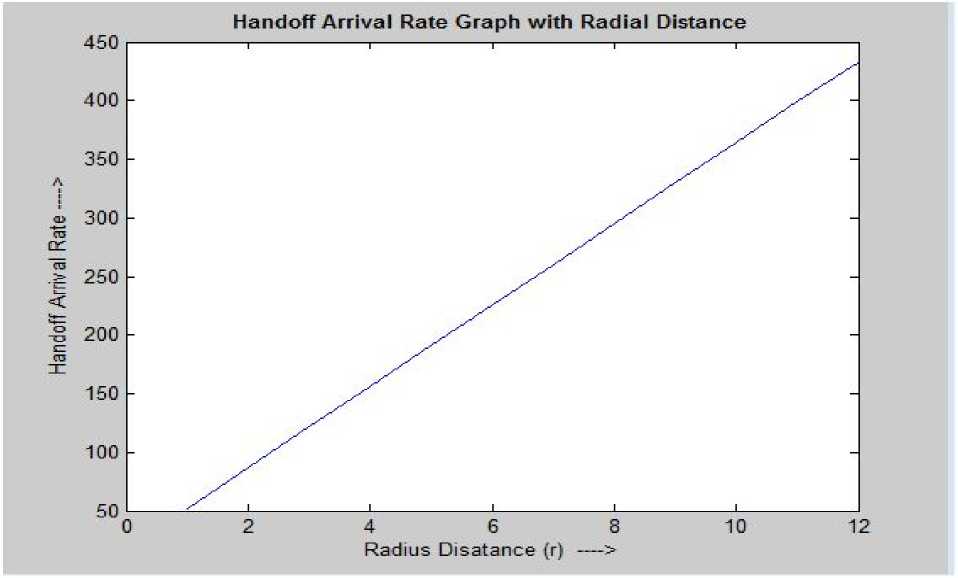
Figure 6. Handoff Arrival Rate vs. Radial Distance
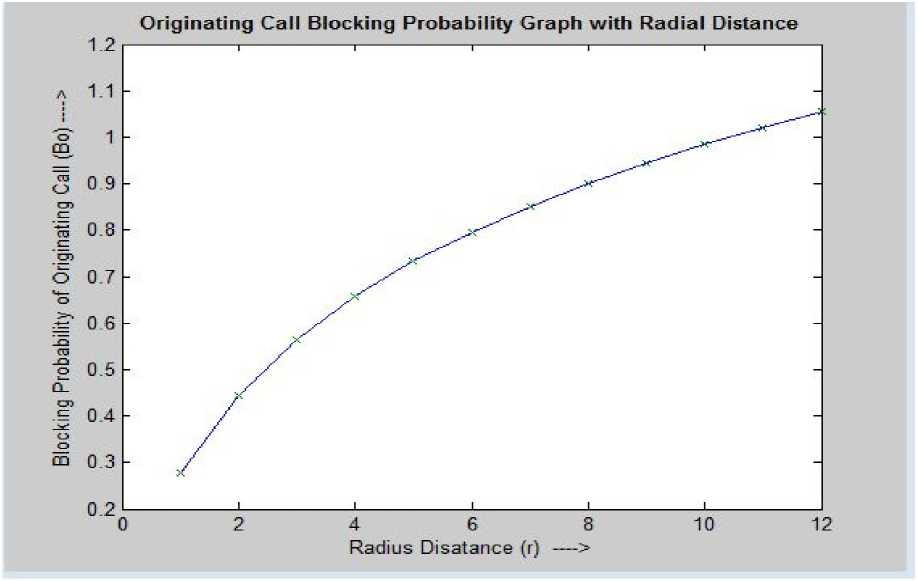
Figure 7. Blocking Probability of Originating Call vs. Radial Distance
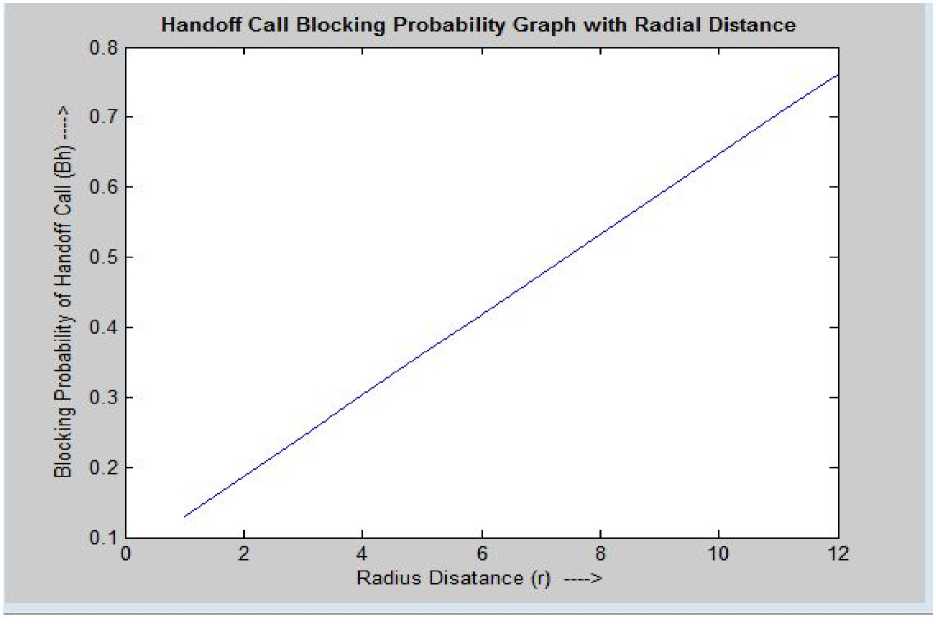
Figure 8. Blocking Probability of Handoff Call vs. Radial Distance
4. Concluding Remarks
In this paper we claim that simulated results guarantee that our approach or the model described performs better like some existing algorithms for Handoff scheme. It is observed that increasing average number of calls per mobile station per day helps in improvement of the blocking probabilities for both originating calls and Handoff request calls. And these values are nearer to their actual values. Another achievement of the proposed model is working out of rate of blocked calls CBR , in addition. Although its behavior is not shown in this paper but similar job has been done in [1][8]. Simulation shows that CBR is increasing in nature with the increase in certain radial distance. After that increases slowly and saturates at r = Rmax . Surprisingly at r > Rmax it is decreasing in nature. It shows that a Handoff just occurred.
However, exact analytical models are difficult to define for the schemes, and if data traffic also needs to be incorporated, it becomes very difficult to have even an approximate model. This is an interesting topic that calls for further research.
Acknowledgements
Список литературы Experimental Analysis of Xie and Kuek's Traffic Model with Handoff Scheme in Wireless Networks
- Biswajit Bhowmik, Arnab Sarkar, Parag Kumar Guha Thakurta, Simulation of Handoff Management Scheme for Improved Priority Based Call Scheduling with a Single Traffic System in Mobile Network, Int. J. of Advanced Research in Computer Science, Volume 1, Number 3, 2010, Pp: 354 – 358.
- N. Mohan, T. Ravichandran, An Efficient Multiclass Call Admission Control and Adaptive Scheduling for WCDMA Wireless Network, European Journal of Scientific Research, Volume 33, Number 4, 2009, Pp:718 – 727.
- Qing-an Zeng and Dharma P. Agrawal, Handbook of Wireless Networks and Mobile Computing, John Wiley & Sons, Chapter 1, 2002.
- Alexe E. Leu, Brian L. Mark, A Discrete-Time Approach to Analyze Hard Handoff Performance in Cellular Networks, IEEE Transactions on Wireless Communications, Volume 3, Number 5, 2004, Pp: 1721 – 1733.
- S. A. Mawjoud, Simulation of Handoff Techniques in Mobile Cellular Networks, Al-Rafidain Engineering ,Volume 15, Number 4, 2007, Pp: 31 – 39.
- Huamin Zhu and Kyung Sup Kwak, An Adaptive Hard Handoff Algorithm for Mobile Cellular Communication Systems, ETRI Journal, Volume 28, Number 5, October 2006, Pp: 676 – 679.
- Biswajit Bhowmik, Pooja, Piyali Sarkar, Nupur Thakur, Experimental Analysis of Single Traffic Priority Handoff Management Scheme and Signal Strength Based Effective Call Scheduling in Wireless Mobile Networks, Final Year Project Report, https://sites.google.com/site/biswajitrbhowmik/academics/projects.
- Biswajit Bhowmik, Smita Roy, Parag Kumar Guha Thakurta, Arnab Sarkar, Priority Based Hard Handoff Management Scheme for Minimizing Congestion Control in Single Traffic Wireless Mobile Networks, International Journal of Advancements in Technology, Volume 2(1), 2011, Pp: 90 – 99.
- Zhenqiang Ye et al, Predictive channel reservation for handoff prioritization in wireless cellular networks, Elsevier, Computer Networks, 51 (2007), Pp: 798 – 822.
- Kishor S. Trivedi, S. Dharmaraja 1, Xiaomin Ma, Analytic modeling of handoffs in wireless cellular networks, Elsevier, Information Sciences 148 (2002) , Pp: 155–166
- P. K. Guha Thakurta, Souvik Sonar, Biswajit Bhowmik, Swapan Bhattacharya, Subhansu Bandyopadhyay, A New Approach on Priority Queue based Scheduling with Handoff Management for Mobile Networks, SEDE, ISCA, 2010, Pp: 69 – 74.
- P. K. Guha Thakurta, Subhansu Bandyopadhyay, A New Dynamic Pricing Scheme with Priority based Tree Generation and Scheduling for Mobile Networks, IEEE Xplore, 2009.
- Jo¨rg Diedericha, Martina Zitterbart, A simple and scalable handoff prioritization scheme, Elsevier, Computer Communications 28 (2005), Pp: 773–789.
- Jinfang Zhang, Jon W. Mark, Xuemin (Sherman) Shen,An adaptive handoff priority scheme for wireless MC-CDMA cellular networks supporting realtime multimedia applications, Elsevier, Computer Communications 28 (2005), Pp: 1240–1250.
- O¨ Zgu¨ R. B. Akan And Buyurman Baykal, Handoff Performance Improvement with Latency Reduction in Next GenerationWireless Networks, Springer, Wireless Networks 11, 2005, Pp: 319–332.
- Biswajit Bhowmik, Pooja, Piyali Sarkar, Nupur Thakur, Received Signal Strength Based Effective Call Scheduling in Wireless Mobile Network, International Journal of Advancements in Technology, Volume 2, Number 2, 2011, Pp: 292 – 305.
- J K Sharma, Operations Research - Theory and Application, Macmillan Publishers, 3/e, 2006.
- S. A. Mawjoud, Simulation of Handoff Techniques in Mobile Cellular Networks, Al-Rafidain Engineering ,Volume 15, Number 4, 2007, Pp: 31 – 39.
- Raymond M. Bendett and Perambur S. Neelakanta, Alternative Metrics for Hard Handoffs in Mobile Communication, ICPWC 2000, IEEE, 2000, Pp: 43 – 46.
- Polychronis Koutsakis , Moisis Vafiadis , Aggelos Lazaris, A new bandwidth allocation mechanism for next generation wireless cellular networks, Springer, Wireless Netw, Volume 16, 2010, Pp: 331–353.
- CUI Hong-yan, TIAN Hui, XU Hai-bo, ZHANG Ping, The Research on Handoff Strategy in Beyond 3G Wireless Networks, The Journal Of China Universities Of Posts And Telecommunications Volume 13. Number 2, 2006.
- Vassilya Abdulova , Isik Aybay, Predictive mobile-oriented channel reservation schemes in wireless cellular networks, Springer, Wireless Netw Volume 17, 2011, Pp: 149–166.
- Thomas H. Cormen, Charles E. Leiserson, Ronald L. Rivest, and Clifford Stein, Introduction to Algorithms, PHI, 2nd Edition, 2006.
- http://www.coai.com/study_papers.php?val=2010.
- http://en.wikipedia.org/wiki/Kolkata#Geography.

